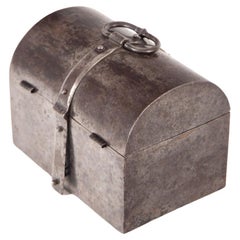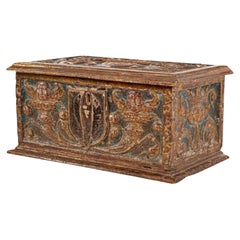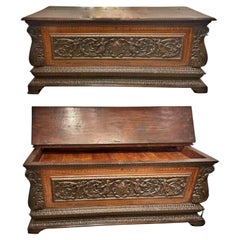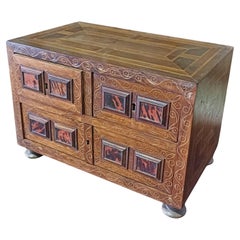Want more images or videos?
Request additional images or videos from the seller
1 of 11
RARE PORTUGUESE CENTER CHAPEL COUNTER 16th Century
$38,294.49List Price
About the Item
- Dimensions:Height: 22.45 in (57 cm)Width: 16.15 in (41 cm)Depth: 10.63 in (27 cm)
- Style:Gothic (Of the Period)
- Materials and Techniques:
- Place of Origin:
- Period:
- Date of Manufacture:16th century
- Condition:Wear consistent with age and use. very good condition.
- Seller Location:Madrid, ES
- Reference Number:1stDibs: LU5779236575892
About the Seller
4.8
Platinum Seller
Premium sellers with a 4.7+ rating and 24-hour response times
Established in 2005
1stDibs seller since 2021
376 sales on 1stDibs
Typical response time: 1 hour
Authenticity Guarantee
In the unlikely event there’s an issue with an item’s authenticity, contact us within 1 year for a full refund. DetailsMoney-Back Guarantee
If your item is not as described, is damaged in transit, or does not arrive, contact us within 7 days for a full refund. Details24-Hour Cancellation
You have a 24-hour grace period in which to reconsider your purchase, with no questions asked.Vetted Professional Sellers
Our world-class sellers must adhere to strict standards for service and quality, maintaining the integrity of our listings.Price-Match Guarantee
If you find that a seller listed the same item for a lower price elsewhere, we’ll match it.Trusted Global Delivery
Our best-in-class carrier network provides specialized shipping options worldwide, including custom delivery.You May Also Like
Hostiary. Bronze. 16th century.
Located in Madrid, ES
Hostiary. Bronze. 16th century.
A circular, tubular bronze box with a finial lid, to which a piece of tubing is attached, forming a press for the interior of the case. It features a...
Category
Antique 16th Century European Other Decorative Boxes
Materials
Bronze
16th-Century Indo-Portuguese Colonial Mother-of-pearl Gujarat Casket
Located in Amsterdam, NL
An exceptional Indo-Portuguese colonial mother-of-pearl veneered casket with silver mounts
India, Gujarat, 2nd half of the 16th century, the silver mounts Goa or probably Lisbon
Measures: H. 16 x W. 24.6 x D. 16.1 cm
An exceptional Gujarati casket with a rectangular box and truncated pyramidal lid (with slopes on each side and a flat top) made from exotic wood, probably teak (Tectona grandis), covered with a mother-of-pearl mosaic. The tesserae, cut from the shell of the green turban sea snail (Turbo marmoratus, a marine gastropod) in the shape of fish scales, are pinned to the wooden structure with silver ball-headed nails. The casket is set on bracket feet on the corners. The masterfully engraved decoration of the silver mounts follows the most refined and erudite Mannerist repertoire of rinceaux and ferroneries dating from the mid-16th century. The high quality and refinement of the silver mounts and, likewise, the silver nails that replaced the original brass pins used to hold the mother-of-pearl tesserae in place indicate the work of a silversmith probably working in Lisbon in the second half of the 16th century.
The Indian origin of this production, namely from Cambay (Khambhat) and Surat in the present state of Gujarat in north India, is, as for the last three decades, consensual and fully demonstrated, not only by documentary and literary evidence - such as descriptions, travelogues and contemporary archival documentation - but also by the survival in situ of 16th-century wooden structures covered in mother-of-pearl tesserae. A fine example is a canopy decorating the tomb (dargah) of the Sufi saint, Sheik Salim Chisti (1478-1572) in Fatehpur Sikri in Agra district in the state of Uttar Pradesh, north India. This is an artistic production, geometric in character and Islamic in nature, where usually the mother-of-pearl tesserae form complex designs of fish scales or, similar to the dishes also made using the same technique, with the thin brass sheets and pins, stylized lotus flowers. The truncated pyramidal shape corresponds, like their contemporary tortoiseshell counterparts also made in Gujarat, to a piece of furniture used in the Indian subcontinent within the Islamic world prior to the arrival of the first Portuguese. This shape, in fact, is very old and peculiar to East-Asian caskets, chests or boxes used to contain and protect Buddhist texts, the sutras.
A similar chest is the famous and large reliquary chest from Lisbon cathedral that once contained the relics of the city's patron saint, Saint Vincent. Both match in shape, having the same kind of socle or pedestal and bracket feet, and in their engraved silver mountings, featuring the same type of refined, erudite decoration. Their differences lie in the silver borders that frame the entire length of the edges of the chest (both the box and the lid), pinned with silver nails, and on the lock plate, shaped like a coat of arms in the Lisbon example. Given the exceptional dimensions of the reliquary casket...
Category
Antique 16th Century Indian Jewelry Boxes
Materials
Silver
$275,607
Free Shipping
H 6.3 in W 9.69 in D 6.34 in
LATE 16th CENTURY SMALL WALNUT BOX
Located in Firenze, FI
Elegant solid walnut small box, entirely hand-carved. The rectangular chest features an opening top, ideal for storing objects. The front, back, and sides are decorated with geometri...
Category
Antique 16th Century Italian Renaissance Decorative Boxes
Materials
Nutwood
Chest. Carved wood, metal. Spanish school, 16th century.
Located in Madrid, ES
Chest. Carved wood, metal. Spanish school, 16th century.
Rectangular casket with a flat lid decorated on the outside with a series of figurative reliefs in a symmetrical arrangemen...
Category
Antique 16th Century Spanish Renaissance Decorative Boxes
Materials
Metal, Other
Rare & Important 16th Century Italian Bronze Jacopo Lodovico del Duca Table Box
Located in Forney, TX
A magnificent antique fall-front box with scarce Medieval period bronze lockplate and hasp attributed to Jacopo and Lodovico del Duca.
Featuring an important Lockplate and Hasp designed circa 1570, exact date of manufacture unknown, attributed to the late 16th century Roman foundry of Jacopo 1520-1604) and Ludovico (1551-1601) del Duca, with no apparent signatures or hallmarks which is typical of the era, but we did not remove it and inspect the back.
Boxes such as this hand various uses but were frequently used by merchants as a writing box - slope during travel and trade, as a small coffer - strong box for storing important documents, money and valuables, as well as a jewelry casket.
This hand-crafted European drop-front box dates to the late 19th century, signed L'PUPLET, adorned with a significantly older Italian fine quality cast bronze lockplate with intricate Renaissance era reliefs, including figures, coat-of-arms, and elongated hasp, mounted on a chest of drawers form solid wooden case, wrapped in exotic Japanesque embossed and gilded metallic paper, having a locking fall-front panel with original key included, opening to reveal three interior drawers, all lined in red velvet. circa 1875
The visually striking textured wallpaper covering the box's exterior displays bamboo, birds, and flowers in the oriental Japanesque taste popular in Europe in the 1860s and 1870s following the forced reopening of foreign trade with Japan in 1858 and the ensuing Japonisme craze.
To the interior of the fall front panel is a gilt circular stamp with the somewhat obscured name of the workshop or store (likely) "L'PUPLET" and the city "Burxelles" which is in Brussels, indicating the box was likely made or retailed there.
Marks to box:
L'PUPLET, BRUXELLES
Inscription:
13, 14, 15 (Interior drawers inscribed on the verso of their backboards in script from top to bottom, respectively)
Provenance / Acquisition:
The origin of the elaborate lockplate with hasp on the front of the piece is more intriguing. At least 76 lockplates of this design have been recorded in major museums, private collections, and in the antiques trade across the Western World. For example, lockplates of this pattern are in the collections of the Rijksmuseum in Amsterdam, the State Museum of Prussian Cultural Heritage in Berlin, the Museum Cicico in Bologna, The Museum of Fine Arts in Boston, the Dallas Museum of Art in Texas, the Victoria & Albert Museum in London, the Museo di Palazzo Venezia in Rome, the State Hermitage Museum in St. Petersburg, and the National Gallery of Art in Washington, DC.[1]
Specialists in Renaissance bronzes, especially Charles Avery...
Category
Antique 16th Century Italian Japonisme Decorative Boxes
Materials
Bronze, Metal
$14,500
H 8.25 in W 7.5 in D 6 in
Large Japanese Namban Lacquer Coffer Arqueta, 16th Century
Located in Amsterdam, NL
A large Japanese Namban lacquer arqueta coffer for the Portuguese market
Kyoto, Momoyama-period, late 16th century
In Hinoki cypress lacquered in ...
Category
Antique 16th Century Japanese Decorative Boxes
Materials
Mother-of-Pearl, Wood
$65,818
Free Shipping
H 16.54 in W 34.45 in D 11.82 in
A 16th/17th Century Style French Red Lacquered Small Chest
Located in Sheffield, MA
An Early & Rare French Red Lacquered
Leather Bound Wood & Iron Small Chest
Height 15 in. Depth 9 in. Width 13 in. ...
Leather Bound Wood & Iron Small Chest
Height 15 in. Depth 9 in. Width 13 in. ...
Category
Antique 18th Century and Earlier French Boxes
Bronze mortar - Italy, 16th century
Located in London, GB
Mortars are an ancient culinary tool, described as indispensable to the preparation of food and medicines in texts like the Egyptian Ebers Papyrus, dating from 1550 BC, and the writi...
Category
Antique 16th Century Spanish Gothic Decorative Bowls
Materials
Bronze
Superb Late 16th Century Signed Colonial Japanese Namban Export Lacquer Coffer
Located in Amsterdam, NL
Superb late 16th century signed colonial Japanese Namban export lacquer coffer
Momoyama period, late 16th/early 17th century, inscribed 'Arisato' on the bottom
H. 30.5 x W. 43...
Category
Antique 16th Century Japanese Lacquer
Materials
Cedar, Lacquer
$57,518
Free Shipping
H 12.01 in W 16.93 in D 9.53 in
Japanese Lacquer Incense Box, Kogo, Momoyama or Edo Period, 16th/17th Century
Located in Austin, TX
A wonderful Japanese lacquer incense box, kogo, with a design of plovers in flight, late Momoyama or early Edo Period, circa 1600, Japan.
The small box, called a kogo, was used to s...
Category
Antique Early 17th Century Japanese Edo Lacquer
Materials
Gold, Pewter
$6,000
H 2.75 in W 3.75 in D 3.75 in
More From This Seller
View AllRare 16th Century Nuremberg Box
Located in Madrid, ES
Rare 16th century Nuremberg box
In iron, measurements: 13 x 18 x 12 cm
Good condition.
Category
Antique 16th Century German Baroque Jewelry Boxes
Materials
Iron
Spanish Renaissance Casket of the 16th Century
Located in Madrid, ES
Spanish Renaissance casket,
16th century
In carved, polychrome and gilded wood decorated with a vase with horns of plenty, heads of cherubs and fruits.
In the lock a shield with two ...
Category
Antique 16th Century Dutch Baroque Decorative Boxes
Materials
Wood
Amazing Chest, Italy, late 16th century
Located in Madrid, ES
Amazing Chest, Italy, late 16th century
93 x 214 x 74 cm
Rectangular shaped chest, in walnut wood. Four bracket feet, with four corners with sculpted leaves. Table top with owl's bea...
Category
Antique 16th Century Italian Gothic Blanket Chests
Materials
Wood
COUNTER CASH 17th Century Flemish
Located in Madrid, ES
COUNTER CASH
17th Century Flemish
in walnut wood with inlays, consisting of two drawers and a drawer.
Signs of use.
Dim.: 31.5 x 44 x 27 cm
good state
Category
Antique 17th Century Dutch Baroque Decorative Boxes
Materials
Wood
(4) Four Portuguese Tiles, 16th Century (1530/1550) Very Rare Collection Items
Located in Madrid, ES
(4) Four Portuguese Tiles, 16th Century (1530/1550) Very Rare Collection Items
Each tile 14cm x 14cm
Original, unrestored
They are very rare, they are collection items, museum ite...
Category
Antique 16th Century Portuguese Baroque Ceramics
Materials
Ceramic
IMPORTANT TRIPTIC FLORENTINE SCHOOL (Italy) 16th Century
Located in Madrid, ES
IMPORTANT TRIPTIC
FLORENTINE SCHOOL (Italy) 16th Century
Oil on wood, representing the Eternal Father, Our Lady with Baby Jesus, Saint Bernadino of Siena, San León, Saint Stephen an...
Category
Antique 16th Century Italian Gothic Paintings
Materials
Paint
Recently Viewed
View AllMore Ways To Browse
Islamic Engraved
Antique Counter Box
Islamic Arch
Exotic Wood Objects
Iranian Box
Malachite Russian
Small Wood Boxes
Antique Money Box
Antique Wood Mosaic
Chinese Red Lacquered Box
Coromandel Box
Dutch Silver Box
Antique Hat Boxes
Antique Russian Objects
Casket Box Glass
Coffer Box
Papier Mache Boxes Antique
Rosewood Box Inlay



